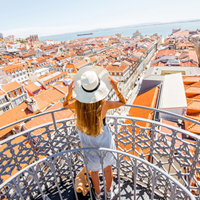7 Weekend Getaways for Digital Nomads Living in Nagoya
Summary: Planning a quick weekend getaway is a great way to save money while still seeing new places. Here are 7 fun weekend getaways for digital nomads living in Nagoya.
Nagoya, is a bustling hub for digital nomads, offering a unique blend of urban convenience and cultural richness. While the city itself is packed with attractions, sometimes a weekend getaway can provide the perfect change of pace. From the popular tourist spots to hidden gems, there are plenty of destinations within easy reach of Nagoya that are ideal for a short break. Here are seven fun weekend getaways that cater to a variety of interests, ensuring that every digital nomad can find their perfect escape.
Kyoto
As the former imperial capital of Japan, Kyoto is a must-visit for anyone interested in Japanese history and culture. With its stunning temples, traditional tea houses, and beautiful gardens, Kyoto offers a serene escape from the modern world. Visitors can explore the famous Fushimi Inari Shrine, walk through the Arashiyama Bamboo Grove, or enjoy the elegance of Kinkaku-ji, the Golden Pavilion. The city is also known for its exquisite kaiseki dining, a traditional multi-course Japanese meal.
How to Get There: Kyoto is about 35 minutes away from Nagoya by Shinkansen (bullet train). Multiple trains run daily, providing a quick and convenient way to reach the city.
Travel Tip: Don't miss the chance to participate in a traditional tea ceremony, which offers a deeper understanding of Japanese culture and hospitality.
Where to Stay: The Ritz-Carlton Kyoto offers luxury accommodations with views of the Kamo River. For a more traditional experience, consider staying at a ryokan, such as Tawaraya or Hiiragiya.
Where to Eat: For an unforgettable dining experience, visit Gion Karyo, where you can enjoy beautifully presented kaiseki meals in the heart of Kyoto's geisha district.
Ise-Shima
The Ise-Shima region is known for the Ise Grand Shrine, one of the most sacred Shinto shrines in Japan. Beyond its spiritual significance, the area offers beautiful coastal scenery, fresh seafood, and the opportunity to experience Ama culture—female divers who collect pearls and seafood. Visitors can also explore the scenic landscapes of the Shima Peninsula or relax in the hot springs of Toba.
How to Get There: Ise-Shima is about two hours from Nagoya by Kintetsu Limited Express train. There are frequent services throughout the day.
Travel Tip: Visit Mikimoto Pearl Island to learn about the history of pearl cultivation and see the Ama divers in action.
Where to Stay: The Shima Kanko Hotel offers luxurious accommodations with ocean views and is known for hosting the 2016 G7 Summit.
Where to Eat: Ama Hut Hachiman offers a unique dining experience where you can enjoy fresh seafood prepared by Ama divers themselves.
Kanazawa
Kanazawa is a beautifully preserved Edo-period city on the coast of the Sea of Japan. It's famous for its well-preserved samurai and geisha districts, the Kenrokuen Garden—one of Japan's "three great gardens"—and the contemporary 21st Century Museum of Contemporary Art. Kanazawa also offers a rich culinary scene, with specialties like fresh seafood and Kaga cuisine.
How to Get There: Kanazawa can be reached in about three hours from Nagoya by the Limited Express Shirasagi train.
Travel Tip: Visit the Nagamachi Samurai District to see the historic samurai houses and the Nomura Clan Samurai Home, which features a stunning garden and tea house.
Where to Stay: Hotel Nikko Kanazawa provides high-rise accommodations with panoramic city views, while the Sumiyoshiya offers a more traditional stay in a family-run ryokan.
Where to Eat: Try the Omicho Market for a variety of fresh foods and local dishes, including the famous Kanazawa seafood.
Kiso Valley
For those seeking an off-the-beaten-path experience, the Kiso Valley offers a journey back in time along the ancient Nakasendo trail. This historic route was once used by samurai, merchants, and travelers during the Edo period. Hiking between the post towns of Magome and Tsumago, visitors can enjoy the picturesque scenery and well-preserved townscapes, with opportunities to stay in traditional inns.
How to Get There: The Kiso Valley is accessible by train from Nagoya to Nakatsugawa Station, followed by a bus ride to Magome or Tsumago.
Travel Tip: Be sure to send your luggage ahead to your next destination using the "hands-free" luggage service, allowing you to enjoy the hike without heavy bags.
Where to Stay: Minshuku Koshinzuka in Tsumago offers a traditional Japanese lodging experience, complete with tatami mats and futon bedding.
Where to Eat: Enjoy soba noodles at one of the many traditional eateries along the trail, such as Magomeya in Magome.
Shirakawa-go and Gokayama
Shirakawa-go and Gokayama are UNESCO World Heritage sites known for their traditional gassho-zukuri farmhouses, some of which are over 250 years old. These villages are set in a remote, mountainous region, offering a tranquil escape and a glimpse into rural Japanese life. The farmhouses, with their steep thatched roofs, are particularly picturesque in the winter when covered in snow.
How to Get There: From Nagoya, take a train to Takayama, and then a bus to Shirakawa-go, which takes around 3 hours in total.
Travel Tip: For a unique experience, stay overnight in one of the farmhouses, many of which have been converted into guesthouses.
Where to Stay: Shiroyamakan offers a traditional stay in a gassho-zukuri farmhouse, complete with an irori hearth and home-cooked meals.
Where to Eat: Sample regional dishes like Hida beef at Irori, a restaurant set in a converted farmhouse with an open hearth.
Inuyama
Inuyama, a small city just north of Nagoya, is home to one of Japan's oldest surviving castles, Inuyama Castle. The castle provides stunning views of the Kiso River and the surrounding area. Inuyama is also known for the Meiji Mura open-air architectural museum, where visitors can explore buildings from the Meiji period. The city's quaint streets and traditional festivals offer a charming and less crowded alternative to more popular destinations.
How to Get There: Inuyama is about 30 minutes from Nagoya by Meitetsu train, with frequent services available.
Travel Tip: Visit during the Inuyama Festival in early April to see the elaborate festival floats and karakuri puppet performances.
Where to Stay: The Inuyama International Youth Hostel offers affordable accommodations with views of the castle, while the Meitetsu Inuyama Hotel provides more upscale lodging.
Where to Eat: Enjoy local specialties like hitsumabushi (grilled eel on rice) at Inuyama Yayoi, a restaurant with a history dating back to the Edo period.
Gujo Hachiman
Gujo Hachiman is a hidden gem nestled in the mountains of Gifu Prefecture. This small town is famous for its pristine waterways and traditional cormorant fishing. Visitors can explore the historic Gujo Hachiman Castle, participate in a food replica workshop (sample-making is a local industry), or dance the night away during the Gujo Odori, one of Japan's longest dance festivals. The town's charming atmosphere and slower pace of life make it an ideal retreat for those looking to unwind.
How to Get There: Gujo Hachiman can be reached by taking a train from Nagoya to Mino-Ota, followed by a bus to Gujo Hachiman, with the journey totaling around 2.5 hours.
Travel Tip: Don't miss the opportunity to create your own food replica souvenir at one of the local workshops, a unique and fun experience.
Where to Stay: Stay at the traditional ryokan Juhachiro, which offers comfortable rooms and a riverside location.
Where to Eat: Sample local cuisine like ayu (sweetfish) at restaurants along the Yoshida River, or try the regional specialty, Keichan (chicken and vegetables grilled in a miso-based sauce), at a local izakaya.
About the Author
 Joshua Wood, LPC is one of the Founders of Digital Nomad Exchange and serves as Co-President of Expat Exchange. Prior to Expat Exchange and Digital Nomad Exchange, Joshua worked for NBC Cable (MSNBC and CNBC
Primetime). Joshua has a BA from Syracuse and a Master's in Clinical and Counseling Psychology from Fairleigh Dickinson University. Mr. Wood is also a licensed counselor and psychotherapist.
Joshua Wood, LPC is one of the Founders of Digital Nomad Exchange and serves as Co-President of Expat Exchange. Prior to Expat Exchange and Digital Nomad Exchange, Joshua worked for NBC Cable (MSNBC and CNBC
Primetime). Joshua has a BA from Syracuse and a Master's in Clinical and Counseling Psychology from Fairleigh Dickinson University. Mr. Wood is also a licensed counselor and psychotherapist.
Some of Joshua's articles include Pros and Cons of Living in Portugal, 10 Best Places to Live in Ireland and Pros and Cons of Living in Uruguay. Connect with Joshua on LinkedIn.

AGS Worldwide Movers can move you to and from anywhere in the world.
Get Quote
![]() Japan Forum
Japan Forum
Talk with other digital nomads and expats in Japan on our Japan forum - meet people, get advice and help others.
![]() Contribute
Contribute
Help others in Japan by answering questions about the challenges and adventures of living in Japan.
Digital Nomads in Japan offer advice about healthcare, hospital visits, emergency rooms visits, finding a doctor and buying health insurance in Japan.


